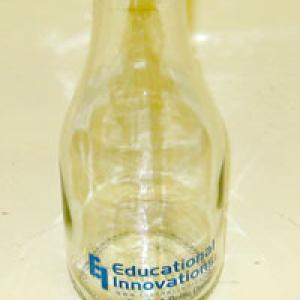College of Liberal Arts & Sciences
2B30.47 - Egg in a Bottle
Take several matches, light them and put them into the bottle. Immediately after they go out place the egg over the mouth of the bottle. As the air in the bottle cools the egg should be forced into the bottle. Invert the bottle and blow into the bottle as hard as you can to increase the pressure inside. The egg should then be forced out of the bottle.
- F-305: "Egg in Bottle", DICK and RAE Physics Demo Notebook.
- 50 Fun Experiments for the Mad Scientist in You, "Egg Trick #2", National Geographic Kids, p. 86. Interesting as this has the wrong explanation.
- 50 Fun Experiments for the Mad Scientist in You, "The Wet Penny", National Geographic Kids, p. 82. Interesting as this has the wrong explanation.
- Martin Gardner, "Egg in the Bottle", Entertaining Science Experiments with Everyday Objects, p. 101.
- "The Fundamentals of a Vacuum", The Boy Scientist, p. 169. Interesting as this has the wrong explanation.
- Janice VanCleave, "17, Rising Water", Teaching the Fun of Physics, p. 28. Interesting as this has the wrong explanation.
- Janice VanCleave, "6, Sonic Egg", Teaching the Fun of Physics, p. 17. Interesting as this has the wrong explanation.
- Joey Green, "Egg in a Bottle", The Mad Scientist Handbook", p. 19.
- Brian Carusella, "Stupid Egg Tricks", Bizarre Stuff website.
- "Floating Candles", Countertop Chemistry, The Science House, North Carolina State University, Experiment 6.
- Bobby Mercer, "Mysterious Levitating Candle", Junk Drawer Chemistry, p. 37.
- Tik L. Liem, "The Swollen Egg", Invitations to Science Inquiry - Supplement to 1st and 2nd Ed. p. 147.
- Herb Strongin, “Investigating the Effect of Burning on Air Pressure“, Science on a Shoestring, p. 77. Interesting as this has the wrong explanation.
- Julius Sumner Miller, Q100 & A100, Millergrams I – Some Enchanting Questions for Enquiring Minds, p. 64 & 112. Interesting as this has the wrong explanation as part of the answer but finally gets to the correct explanation.
Disclaimer: These demonstrations are provided only for illustrative use by persons affiliated with The University of Iowa and only under the direction of a trained instructor or physicist. The University of Iowa is not responsible for demonstrations performed by those using their own equipment or who choose to use this reference material for their own purpose. The demonstrations included here are within the public domain and can be found in materials contained in libraries, bookstores, and through electronic sources. Performing all or any portion of any of these demonstrations, with or without revisions not depicted here entails inherent risks. These risks include, without limitation, bodily injury (and possibly death), including risks to health that may be temporary or permanent and that may exacerbate a pre-existing medical condition; and property loss or damage. Anyone performing any part of these demonstrations, even with revisions, knowingly and voluntarily assumes all risks associated with them.
